|
|
|
Sort Order |
|
|
|
Items / Page
|
|
|
|
|
|
|
| Srl | Item |
| 1 |
ID:
104796
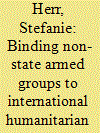

|
|
|
|
|
| Publication |
Frankfurt, Peace Research Insititute Frankfurt (PRIF), 2010.
|
| Description |
38p.
|
| Series |
PRIF report no.95
|
| Standard Number |
9783942532051
|
|
|
|
|
|
|
|
|
|
|
|
Copies: C:1/I:0,R:0,Q:0
Circulation
| Accession# | Call# | Current Location | Status | Policy | Location |
| 056057 | 341.481/HER 056057 | Main | On Shelf | General | |
|
|
|
|
| 2 |
ID:
153613
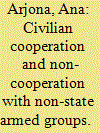

|
|
|
|
|
| Summary/Abstract |
Terms like ‘support’ and ‘collaboration’ are often used interchangeably to denote a loose set of acts or attitudes that benefit non-state armed groups (NSAGs). However, these terms are seldom defined, and the alternatives available to civilians are rarely identified. Moreover, existing approaches overlook that the interaction between civilians and NSAGs is often one between ruler and ruled, which makes obedience and resistance central. This paper proposes to conceptualize the choices available to civilians as forms of cooperation and non-cooperation, offers a typology, and discusses the implications for theory building on civilian and NSAG behavior, and on the functioning of armed social orders.
|
|
|
|
|
|
|
|
|
|
|
|
|
|
|
|
| 3 |
ID:
080880
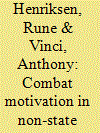

|
|
|
|
|
| Publication |
2008.
|
| Summary/Abstract |
Existing analyses of non-state armed-group combat motivations are inadequate because they essentialize combat motivation, fail to recognize the polymorphous character of non-state warfare, and confound agency and structure by equating individual combatant motivation with the context of the conflict. In order to account for the more dynamic nature of combat motivation in armed groups versus conventional militaries, this article offers a two-dimensional framework for understanding combatant motivation. The first dimension is based on context-specifically, terrorist, insurgent and warlord forms of warfare-and the second on individual motivation-including communitarian, economic, and existential motivations. The article then illustrates the interplay between these two dimensions.
|
|
|
|
|
|
|
|
|
|
|
|
|
|
|
|
| 4 |
ID:
072899
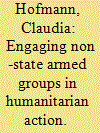

|
|
|
|
|
| Publication |
2006.
|
| Summary/Abstract |
Formal actors are faced with vast shortcomings in articulating a legal foundation for engaging non-state armed groups. This essay addresses the difficulties, differences and commonalities for state and non-state actors in engaging with non-state armed groups. It demonstrates how non-governmental organizations offer the potential to fill the gap in the international legal regime by employing lower-key initiatives that avoid political issues such as the legitimization or recognition of non-state armed groups. The essay concludes that 'small agreements' in the humanitarian field bear the capacity to contribute enormously to prospective peace processes.
|
|
|
|
|
|
|
|
|
|
|
|
|
|
|
|
| 5 |
ID:
090441
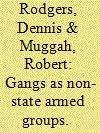

|
|
|
|
|
| Publication |
2009.
|
| Summary/Abstract |
Gangs are popularly considered to be the major security threat facing the Central American region. In focusing on the origins and dynamics of gangs in the region, this article seeks to broaden conceptualizations of non-state armed groups by expanding the theoretical optic from a narrow focus on war and post-war contexts to a wider spectrum of settings, actors, and motivations. It highlights a category of actors that does not explicitly seek to overthrow the state, but rather progressively undermines or assumes certain state functions. The article also reveals how efforts to contain and regulate gangs flow from their imputed motives, with interventions influenced by whether they are conceived as a criminal or political threat. At the same time, coercive regulation tend to be favoured even when such repressive interventions exacerbate gang violence, for reasons that reveal the deeper underlying political, social, and economic challenges facing the Central American region.
|
|
|
|
|
|
|
|
|
|
|
|
|
|
|
|
| 6 |
ID:
189120
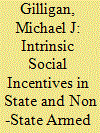

|
|
|
|
|
| Summary/Abstract |
How do non-state armed groups (NSAGs) survive and even thrive in situations where state armed groups (SAGs) collapse, despite the former’s often greater material adversity? We argue that, optimizing under their different constraints, SAGs invest more in technical military training and NSAGs invest more in enhancing soldiers’ intrinsic payoffs from serving their group. Therefore, willingness to contribute to the group should be more positively correlated with years of service in NSAGs than in SAGs. We confirm this hypothesis with lab-in-the-field and qualitative evidence from SAG and NSAG soldiers in Nepal, Ivory Coast, and Kurdistan. Each field study addresses specific inferential weaknesses in the others. Assembled together, these cases reduce concerns about external validity or replicability. Our findings reveal how the basis of NSAG cohesion differs from that of SAGs, with implications for strategies to counter NSAG mobilization.
|
|
|
|
|
|
|
|
|
|
|
|
|
|
|
|
| 7 |
ID:
173388
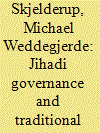

|
|
|
|
|
| Summary/Abstract |
Based on unique field work in southern Somalia, this article explores how the interrelationship between jihadi insurgent rulers and traditional authority structures fostered local order in the southernmost part of Somalia in the period 2008 to 2012. While the Jihadi insurgent group al-Shabaab’s state project was profoundly inspired by jihadi-Salafi ideology when it conquered large parts of South-Central Somalia in 2008–2009, it developed a strategy to cooperate with and co-opt local authority structures. This was partly a pragmatic approach in order to gain control of local institutions and populations. However, utilizing the local clan elders was a practical and cost-effective arrangement through which al-Shabaab could collect material resources, such as money, weapons, new recruits and other local resources. By sustaining the traditional authority structures, al-Shabaab also fostered a degree of trust and legitimacy from the local populations.
|
|
|
|
|
|
|
|
|
|
|
|
|
|
|
|
| 8 |
ID:
191480
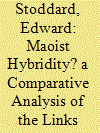

|
|
|
|
|
| Summary/Abstract |
While the recent literature on hybrid warfare has focused overwhelmingly on Russia, military tactical hybridity among non-state actors has received less attention, and minimal comparative examination. This is surprising as the range of non-state actors successfully using hybridized irregular-conventional tactics (increasingly symmetrically) against states has grown. Examining this phenomenon comparatively in three divergent cases (Islamic State, Boko Haram, the Houthi Movement), this article tests an often-overlooked argument stating that military hybridity among non-state actors is a result of these groups’ common adoption of a specific form of Maoist-style warfare strategy – emulative insurgency.
|
|
|
|
|
|
|
|
|
|
|
|
|
|
|
|
| 9 |
ID:
174814
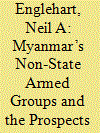

|
|
|
|
|
| Summary/Abstract |
Myanmar has suffered the world’s longest civil war, with continuous combat since shortly before the country’s independence from the UK in 1948. A new National Ceasefire Agreement has raised hopes that peace may finally be in sight. However, optimism should be tempered by a recognition the peace process has not built much trust, reduced the number of non-state armed groups in the country, their total size, or significantly improved their human rights behavior. This is demonstrated through an analysis of original data on the major non-state armed groups active in Myanmar between 1985 and 2017. Peace will require hard political work leading to disarmament, restraining the military, and reassuring the country’s ethnic minority groups that their rights and interests will be respected even without the threat of insurgent violence.
|
|
|
|
|
|
|
|
|
|
|
|
|
|
|
|
| 10 |
ID:
145533
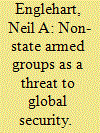

|
|
|
|
|
| Summary/Abstract |
What kind of security threats do non-state armed groups pose, and to whom? The literature has tended to take the state as a reference point for the study of non-state armed groups: insurgents have long been regarded as domestic military threats, and since 9/11, terrorism has been increasingly treated as a major transnational military threat. Because literature on armed non-state actors typically situates them in the context of war or protracted conflict, the state-centric and militarized view of these groups is rarely contested. However, data on 232 armed groups in twenty-three Asian countries from 1985 to 2014 show that the primary threat such groups most consistently pose is to the human security of local civilian populations, rather than the military security of states. A human security perspective suggests alternatives to military responses, the need for more tailored non-military interventions, and the necessity of improved data collection on non-state armed groups that exist in- and outside the context of conventional war.
|
|
|
|
|
|
|
|
|
|
|
|
|
|
|
|
| 11 |
ID:
159365
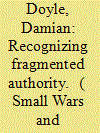

|
|
|
|
|
| Summary/Abstract |
The rollback of Daesh’s territorial control during 2017 has (re-)established an area of limited statehood in large parts of Iraq that may endure for many years. The government of Iraq projects its authority into a large geographical and political space that it shares with a multitude of other state, non-state and hybrid actors, competing and collaborating to achieve advantageous security and political outcomes. This paper examines the heterarchy of actors in post-Daesh Iraq to develop a typology and start a critical discussion about post-Westphalian alternatives for security governance in Iraq during the coming period of reconstruction and reconciliation.
|
|
|
|
|
|
|
|
|
|
|
|
|
|
|
|
| 12 |
ID:
089562
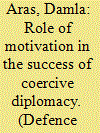

|
|
|
|
|
| Publication |
2009.
|
| Summary/Abstract |
Understanding the nature of state motivation in sponsoring non-state armed groups is of great significance to the countries countering these sponsor-states. An analytical understanding of this phenomenon entails comprehending its characteristics which is translated as its strength. Such an understanding is crucial because several coercing countries have failed to persuade their opponents, due to their strength of motivation, to comply with their demands despite their military superiority. Given the increasing number of states using coercive strategies, developing realistic and effective strategies by understanding the opponent's motivation becomes all the more important. Despite its importance, although there are studies examining the underpinnings of the motivations of non-state armed groups, only a few studies analyse the polymorphous character of the sponsor-state's motivations, let alone its impact on the outcome of the coercing state's strategies.1
|
|
|
|
|
|
|
|
|
|
|
|
|
|
|
|
| 13 |
ID:
089957
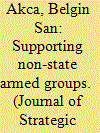

|
|
|
|
|
| Publication |
2009.
|
| Summary/Abstract |
States have suffered equally, if not more, from violence generated by Non-state Armed Groups (NAGs), such as ethnic and religious insurgencies and terrorists, than violence directly generated by their counterparts. This does not undermine the fact that states occasionally provide support to these groups in the form of safe havens, weapons, and funding. This paper argues that state support is a function of the states' vulnerability in extracting and mobilizing resources to secure their borders. In contrast to the conception that weak or failed states provide the largest pool of resources to NAGs, the relatively strong states still prevail as their most fervent supporters. The preliminary evidence also suggests that NAGs serve as substitutes for allies.
|
|
|
|
|
|
|
|
|
|
|
|
|
|
|
|
| 14 |
ID:
182562
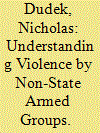

|
|
|
|
|
| Summary/Abstract |
This paper uses a case study of Sierra Leone’s Revolutionary United Front to help explain when and where non-state armed groups (NSAGs) use violence, and what type of violence such groups use. The first part of the paper compares ‘ideological’ and ‘instrumental’ theories and finds strong support for ‘instrumental’ explanations, particularly contestation theory. The second part of the paper seeks to explain the patterns of contestation, which the existing scholarship treats as an independent variable, and finds that the patterns of contestation are explained by the interaction of the state and NSAG’s policy goals.
|
|
|
|
|
|
|
|
|
|
|
|
|
|
|
|
| 15 |
ID:
134174
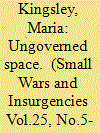

|
|
|
|
|
| Publication |
2014.
|
| Summary/Abstract |
The Ecuadorian state has long been absent from the regions along its northern border with Colombia. I argue that this lack of state presence has allowed non-state armed groups and criminal organizations space to not only operate from these areas, but also, to challenge and change the relationship between local populations and the Ecuadorian state. After reviewing theoretical approaches to concepts of changing security paradigms and ungoverned space, the article details the conditions that have allowed armed groups, specifically the FARC, to take advantage of the lack of state presence along Ecuador's northern border.
|
|
|
|
|
|
|
|
|
|
|
|
|
|
|
|
| 16 |
ID:
165068
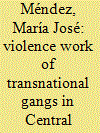

|
|
|
|
|
| Summary/Abstract |
According to international relations scholars, an important change taking place in the post-Cold War context concerns the lethality of non-state armed groups (NSAGs). Underlying this observation is the conventional assumption that non-state violence is intrinsically illegitimate. This article shifts the analysis of violence away from the terrain of legitimacy, which tends to moralise the difference between state and non-state forces, and towards the terrain of work, where their violence features as part and not separate from a shared political economy. I propose the notion of violence work as a resourceful analytic into the dialectics of everyday violence and the complex processes of value production in social life. Against the background of the extreme cruelty attributed to transnational gangs in Central America, I argue that their violence work is expressive of prevailing modes of accumulating wealth in the region. Drawing on multi-sited fieldwork in Honduras, Guatemala, El Salvador and Mexico, I show how gang violence work animates a system of economic cooperation that engages a wide array of subjects who traverse state/non-state and legal/illegal divides.
|
|
|
|
|
|
|
|
|
|
|
|
|
|
|
|
| 17 |
ID:
148932
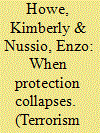

|
|
|
|
|
| Summary/Abstract |
The implementation of peacebuilding activities, including the demobilization of non-state illegal actors, does not necessarily bring about a reduction in violence. While there are several theories that address the causes of persistent violence, there are few that adequately explain why rates of violence can rapidly increase in a post-demobilization context. Using the method of process tracing, this article explores the case of Córdoba Department, Colombia, where rates of violence have increased after the demobilization of paramilitary groups (Autodefensas Unidas de Colombia [AUC]) in 2005. We argue that the AUC created and maintained a monopolistic illegal protection system during its years of operation, and this type of local order was able to contain violence. After demobilization, the protection system was disrupted and as a consequence, new competition between post-demobilization criminal organizations for existing illegal rents developed, petty crime became pervasive, and revenge killings spiked, thus contributing to increased rates of violence in the post-demobilization period. Our theory about the breakdown of protection finds support in other AUC-dominated regions of Colombia.
|
|
|
|
|
|
|
|
|
|
|
|
|
|
|
|
|
|
|
|
|